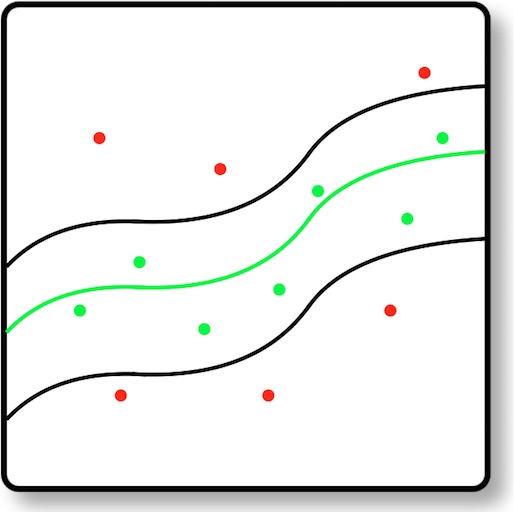 The above schematic shows the uncertainty bounds (black lines) around a set of hypothetical measurement values. A good measurement should lie inside these bounds (green points) while a bad measurement lies outside these bounds (red points). The above schematic shows the uncertainty bounds (black lines) around a set of hypothetical measurement values. A good measurement should lie inside these bounds (green points) while a bad measurement lies outside these bounds (red points). | We get requests all the time for measurements, and everyone wants to make sure it is “NIST traceable.” Of course, NIST traceability is not a bad thing, but what precisely does it mean? An accurate measurement? A precise measurement? A measurement made by NIST at NIST facilities? Believe it or not, NIST traceability is not necessarily any of these things. There are innumerable references online explaining this, so this will not be an exhaustive answer. For that, refer to some of the links below. NIST documentation makes reference to the International Vocabulary of Metrology[1] published by the BIPM[2]. That definition is the “property of a measurement result whereby the result can be related to a reference through a documented unbroken chain of calibrations, each contributing to the measurement uncertainty.” So the definition of traceability is more concerned with the pedigree of a measurement than its accuracy. The effect of this pedigree is that the uncertainty of the measurement has been quantified, and every traceable measurement should be accompanied by the uncertainty of that measurement. Otherwise, you are unsure of the “unbroken chain of calibrations” that must ultimately lead to a NMI (National Metrological Institute”). So with traceability comes uncertainty. The BIPM defines uncertainty as “non-negative parameter characterizing the dispersion of the quantity values being attributed to a measurand, based on the information used.” Uncertainty is concerned with the spread (“dispersion”) of a series of measurements. Uncertainty is closely related to repeatability or equivalently precision. A measurement system that can make very repeatable measurements can be said to add only a small amount to the overall uncertainty. Each new instrument that is added to the “unbroken chain” of measurements adds some component of uncertainty. The final result is the combined uncertainty. It is this combined uncertainty certificate that should accompany any traceable measurement. BIPM also provides a document[3] that has more than you could possibly ever want to know about uncertainty, the Guide to the Expression of Uncertainty in Measurement (GUM). Of course, we usually want an accurate measurement as well. In terms of the above, a more accurate measurement is one with a smaller uncertainty. What is “small”? That is really up to your application. A perfectly useful tape measure used for commercial carpentry and home building might be accurate to a fraction of a millimeter. But even an inexpensive micrometer in your optics lab should be able to measure within a few microns. And a device used to measure the wavelength of light had better be accurate to a small handful of nanometers. And the smaller the uncertainty, the more the measurement is going to cost. That’s just the way of the (metrological) world. In summary, traceability is all about the unbroken chain of uncertainty propagation, ultimately leading back to an NMI. Anyone claiming to make traceabile measurements should provide the uncertainty of their measurement system, and relate that system to the appropriate NMI. References JCGM 200:2008, International vocabulary of metrology – Basic and general concepts and associated terms (VIM Third Edition, 2008) International Bureau of Weights and Measures (In French: Bureau International des Poids et Mesures). BIPM is the international organization that coordinates all the national metrological institutes (NMI). NIST is the NMI for the U.S. Guide to the Expression of Uncertainty in Measurement (GUM) |
 The above schematic shows the uncertainty bounds (black lines) around a set of hypothetical measurement values. A good measurement should lie inside these bounds (green points) while a bad measurement lies outside these bounds (red points).
The above schematic shows the uncertainty bounds (black lines) around a set of hypothetical measurement values. A good measurement should lie inside these bounds (green points) while a bad measurement lies outside these bounds (red points).